Have you started planning your China tours 2022 now? Here is a ready-made plan for you. If you are a person interested in history and culture of China, this itinerary is best for you. This itinerary includes Beijing and Pingyao Tour 2022, Xi'an and Shanghai Tour 2022. Beijing and Xi'an are respectively one of the four ancient capitals in China, and the Pingyao Ancient City is one of the four ancient cities in China. After visiting the three ancient cities and feeling the long history of China, you will come to the magic city-Shanghai to explore China's modernization in 2022. In addition, you will take the high-speed train from Beijing to Pingyao and from Pingyao to Xi'an. On the high-speed train, you can experience the speed of China, up to 350 kilometers per hour. Contact us and make your China tour happen!

Today, your flight will land in the capital, Beijing. Upon arrival at the Beijing Capital International Airport or the newly-built “starfish” Beijing Daxing International Airport, our experienced local guide will greet you in the arrival hall after you claim luggage and clear customs. You will see our guide holding your name board as you exit the hall. Then, you will be transferred to the hotel in the downtown area. After arrive at the hotel, our guide will assist you with check-in. After that, we will leave the rest of the day for you to recover from the long flight and jet lag and get yourself prepared for the fascinating 12-day journey.
Beijing, as one of the oldest cities in the world and one of China’s Four Ancient Capitals, boasts splendid culture and rich history dating back over 3,000 years. It has served as the political and cultural center of China’s imperial dynasties for most of the past eight centuries, making Beijing “a Great Museum of China’s Imperial Past”. Some of the attractions are highlighted by UNESCO World Heritage Sites, such as the Summer Palace, the Forbidden City, the Temple of Heaven, and the Ming Tombs.
Beijing is widely praised for not only its glorious past but also remarkable modernity. Today’s Beijing offers you a chance to appreciate modern China. You could see various hi-tech infrastructures and super-modern buildings, like the Bird’s Nest, China’s national stadium where the 2008 Olympic Games was held. As the 2022 Winter Olympics is approaching, Beijing will soon become the first city ever to host both the Summer and Winter Olympics. Beijing is also a world-leading center for science, technological innovation, and economic entrepreneurship. It is home to “China’s Silicon Valley”- the Zhongguancun Area, and over 90 universities and academic institutes, including world-known universities like Peking University and Tsinghua University.
After a nice rest, you will begin the tour by experiencing the charms of ancient Beijing as a starter. You will meet the guide in the lobby after your breakfast at the hotel. Our guide will drive you to the historic Tian’anmen Square. The square lies at the center of Beijing’s north-south axis and is considered “the Heart of Beijing”. As one of the world’s largest public urban square, it takes up more than 400,000 square meters, which is about the size of the Vatican and can accommodate over 1 million people at the same time. As a sight with significant historical importance, the square has witnessed many historic ceremonies and assemblies, including the founding ceremony of the People’s Republic of China. It houses many landmarks, such as the Monument to People’s Heroes, the Great Hall of the People, and the Mausoleum of Mao Zedong. You could wear a pair of comfortable shoes, walk around, and explore the vast square.
After walking through Tian’anmen Square, we will come to this morning’s highlight: the 600-year-old Forbidden City (closed each Monday), which is also known as the Palace Museum. The Forbidden City is most known as the imperial palace complex for 24 emperors and their households during the Ming (1368-1644) and Qing Dynasties (1636 - 1912). The Forbidden City is the world’s largest collection of preserved ancient wooden structures, having a total of 9,999 rooms. Our knowledgeable guide will provide you some interesting facts and anecdotes about the Forbidden City as you explore the fascinating halls and pavilions. Today, it is a popular tourist site open to visitors around the world. However, back in the feudal dynasties, it was guarded with by many soldiers. The commons were forbidden to enter. Even high-ranking officials were not allowed to enter without the emperor’s permission. It was very likely that those who disobeyed the rule got executed.
The extravagant Forbidden City boasts majestic traditional Chinese architectures and an abundant collection of invaluable cultural relics. It is home to numerous ancient art treasures, like Gu Kaizhi’s Nymph of the Luo River (Luoshenfu Tu) from the Jin Dynasty (266 - 420) and Zhang Zeduan’s Life along the Bian River at the Pure Brightness Festival (Qingming Shanghe Tu) from the Song Dynasty (960 - 1279). The Last Emperor, a movie about the life of Puyi, the last emperor of China, was shot in the Forbidden City. This film won 9 awards at the 60th Academy Awards and it was directed by legendary Italian director Bernardo Bertolucci. If you have watched this movie, you must know something about the Forbidden City.
After a busy morning of sightseeing, we will bring you to a local restaurant for lunch, where you could have a taste of authentic Chinese dishes.
After lunch, you will go to an imperial garden, the Summer Palace. Located 20 kilometers northwest of downtown Beijing, the garden was built by Emperor Qianlong to honor his mother in 1764. In the Qing Dynasty, the 300-hectare Summer Palace served not only as a summer resort but also as an important political and diplomatic center, where Empress Dowager Cixi and Emperor Guangxu administered state affairs and met foreign missionaries in the late Qing Dynasty. Composed of mainly the Longevity Hill, Kunming Lake, and over 3,000 man-made ancient buildings, the Summer Palace was considered the largest and the best-preserved imperial garden in China. It greatly influences Chinese horticulture and landscape arts and has long been recognized as “the Museum of Imperial Gardens.” We recommend you walk along the 700-meter Long Corridor and climb up Longevity Hill to enjoy the delightful overview of the garden scenery.


Today, your tour in Beijing will continue with other memorable attractions. In the morning after your breakfast at the hotel, we will drive for about 1 hour to appreciate the largest mausoleum group where many emperors were buried, the Ming Tombs. The Ming Tombs, located 45 kilometers northwest of downtown Beijing at the foot of Tianshou Mountain, covers an area of over 120 square kilometers. As an outstanding representative of the ancient Chinese mausoleum, it is known for its long history and palatial structures with rich traditional Chinese architectural wisdom.
The 7.3-kilometer-long Sacred Way (or the Divine Road) in the Ming Tombs is the main gateway leading to the 13 imperial tombs. It was believed in ancient times that the emperor who was considered the Son of Heaven, would return to Heaven through this road. Along the Sacred Way, you will see dozens of interesting stone statues of guardians and officials as you walk from south to north, like divine dragons, phoenix, tortoise, horse, Xie Zhi (mythological Chinese unicorn).
After passing through the Sacred Way, we will enter the Ding Tomb of the Ming Tombs. The Ding Tomb is the only excavated one for archaeological exploration and opens to the public among the 13 tombs. It is the joint resting place of the longest-ruling monarch of the Ming Dynasty, Emperor Zhu Yijun (reigning from 1572 to 1620) and his two empresses: Empress Xiaoduan and Empress Xiaojing. Surrounded by mountains on three sides, the 180,000-square-meters Ding Tomb features exquisite design. It should be noted that all the five vaulted chambers of the Ding Tomb were built of stone without using any beams or columns. According to historians and archeologists, it is estimated that the cost of building this tomb equals the two-year tax revenue that the country made at that time.
After lunch, you will head northwest, and then spend the afternoon discovering the spectacular Badaling Great Wall, which needs about a 45-minute drive from the Ding Tomb. This section of Great Wall was first built in the Warring States Period (453 BC - 221 BC), and then rebuilt in the Ming Dynasty. The 2,500-year-old Great Wall has drawn tens of millions of visitors from home and abroad, including foreign leaders and celebrities, such as former U.S. presidents George W. Bush, Jimmy Carter, and Richard Nixon, Queen Elizabeth II of the UK, and Nelson Mandela. It has been ranked as one of the destinations people should visit once in a lifetime. Our guide will walk with you and tell you the best place to take photos.

After breakfast at the hotel, you will start today’s journey at the Temple of Heaven, the imperial altar where emperors of the Ming and Qing Dynasties worshiped heaven. It is the largest and most representative existing masterpiece among China’s ancient sacrificial complexes, symbolizing ancient Chinese’s pursuit of harmony between human and heaven. Today, the Temple of Heaven with a quiet environment has become an attraction to locals and visitors. As you walk in it, you may come across local people enjoying various unique activities, like playing Tai Chi, calligraphy writing on the paved road, kicking shuttlecock, walking with caged birds in hand, playing chess, etc. The scenic area also boasts over 60,000 varieties of trees. You may find what the locals call “the grandfather tree”, a 500-year-old cypress with nine dragon-like winding branches.
After a leisure tour at the Temple of Heaven, our guide will lead you to local Hutong, the narrow lanes, or alleys between the courtyard houses dwelled by Beijing people in the past. Hutong stretches out in all directions, connecting the courtyard houses in the city and bringing local people closer. You will also get to hop on the rickshaw to ride through the hutong. During the rickshaw tour you will also pay a visit to a local family who have lived in those hutongs for generations. There you will get to feel the deep and warm relationship among people and experience the traditional lifestyle of the Beijinger.
In the afternoon, you will immerse yourself in the rich cultural and religious life in ancient Beijing. First, you will travel to the Confucian Temple, the place where ancient and present Chinese pay homage to Confucius, the greatest thinker and educationalist in ancient China. In the temple built about 700 years ago, you could find many stone tablets and stone stele pavilions that record the historical information of ancient Confucius teachings. You could also find various remarkable traditional Chinese relief patterns like two flying dragons playing a pearl among clouds.
Later, our guide will take you to the largest and most perfectly preserved lamasery in China, the Lama Temple, also known as the Yonghe Lamasery. This place was initially built for Emperor Yongzheng of the Qing Dynasty in 1694 when he was just a prince. It was formally changed into a lamasery in 1744 and later became the centre of Tibetan Buddhist affairs in the country. In this temple, you will get a close look at the oddly-posed statues of many Arhats, Buddhas, Bodhisattvas, as well as Heavenly Kings. Some hold an umbrella, some a sword, some a Pipa (ancient Chinese instrument), and some a snake and treasure. Some of the steles at the temple are engraved with Tibetan Buddhism stories and the words of ancient lamas and the emperors. So, you may have the opportunity to grasp the meaning of Lamaism with help from our guide in this sacred temple.


 Pingyao
Pingyao After a nice breakfast at the hotel, you will say goodbye to Beijing and you are about to embark on a new journey at one of “China’s Four Ancient Cities”, Pingyao City in Shanxi Province. Our guide will take you to the Beijing West Railway Station for the estimated train G627 8:05 /12:03 to Pingyao. Upon your arrival, our guide in Pingyao will meet you up at the train station and give you a preview of the ancient city famed for its importance in Chinese economic history and its well-preserved architectures of the Ming and Qing Dynasties. We hope you are ready to be amazed by a large number of well-preserved ancient buildings.
In the afternoon, you will head to the first stop – the Pingyao Ancient City, which is also known as “the Giant Turtle City” because of its turtle-shaped Ancient City Wall. Pingyao Ancient City epitomizes northern China’s prosperity in the Ming Dynasty. You will see well-preserved city walls, traditional residences, time-honored shops, and antique stores, including pawnshops, handicraft workshops, and exchange shops. If you are interested in how ancient Jin (shortened for Shanxi Province) merchants developed business, we recommend you to go to the almost 200-year-old Rishengchang Former Bank, which is believed to be “the Father of China’s Banks.” It now displays historical items about ancient Jin merchants. In addition, if you happen to be a martial art lover, you could also go to the ancient security guard companies, which was the ancient agency that delivered valuable items and guarded rich men or officials. There you may get a close look at ancient China’s delivery tools and martial weapons, as well as special training courts for the guards to practice martial skills.

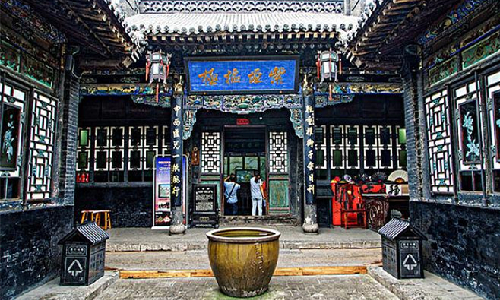
In the morning, after breakfast at the hotel, you will first visit a luxurious residence built nearly 300 years ago, the Wang Family Courtyard, which is about 50 kilometers from Pingyao Ancient City. We will drive southwest for about 1 hour to get there. The opulent Wang Family Courtyard is famous for its grand scale, magnificent architectural style, and prominent layout. It covers an area of about 250,000 square meters, and is also known as “the folk Forbidden City”, or “the Best of the Best Residences in China.” There are 231 courtyards and 2,078 rooms in the Wang Family Courtyard. The distribution of these buildings here is strictly in accordance with the feudal hierarchy, for example the senior people and the people with high official positions always live in the best houses. The building group here is not only an example of ancient residential architecture but also a museum of folk customs and folk arts. You will see many cultural relics that the rich people used to decorate their dwellings like exquisite crafts and ornate stone, brick and wood carvings in shapes of the dragon, phoenix, tortoise, etc.
After touring the Wang Family Courtyard, you will have authentic Shanxi dishes for lunch at a well-selected local restaurant.
In the afternoon, you will spend about 30 minutes getting to the next attraction of this journey – the Zhangbi Ancient Castle. The castle is about 35 kilometers northeast of the Wang Family Courtyard. In ancient China, it was considered a key military fortress complex. It consists of the castles where locals and soldiers once dwelled as well as the three-tiered underground defense tunnels where soldiers could immediately move to, ambush, and even initiate attacks in times of warfare. Some of the tunnels are only 1-meter deep; some are about 20-meter deep. There are watching posts, air vents, barns, resting caves, directing caves, etc. Together they form a “10-Kilometer-Long Underground Great Wall.”
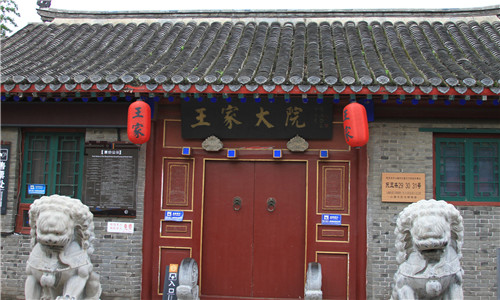
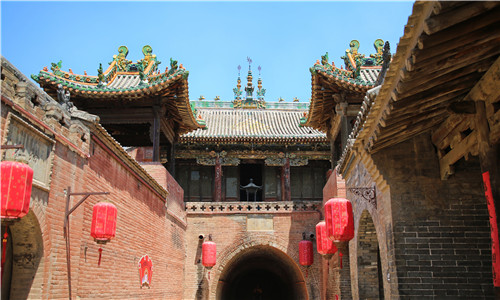
 Xi’an
Xi’an After breakfast, you will visit the Shuanglin Temple, which is just about six kilometers away from the Pingyao Ancient City. Having a history of over 1,400 years, the temple is renowned as “the Museum of Ancient Painted Sculptures.” It is home to a huge number of elaborately painted clay sculptures and elaborate statutes. Here you may trace the refined skills of the artisans of the ancient Song, Yuan(1271-1368), Ming, and Qing Dynasties. The temple consists of ten halls, including the Mahavira Hall, the One-thousand Buddha Hall, the Bodhisattva Hall, the Heavenly King’s Hall, the Arhats’ Hall, and other halls. While touring the halls, you will see many magnificent Buddhist sculptures with varied heights of from 0.3 meters to 3.5 meters. With the fine traditions of past dynasties in highly realistic styles, all the sculptures are vividly portrayed and their facial expressions differ from each other based on their personalities. Some look furious, some frown, and some have their lips tightly closed.
After spending the morning at the Shuanglin Temple, you will say goodbye to Pingyao. Your guide will take you to the railway station to take the estimated train D2519 13:18 /16:26 to the ancient capital of 13 imperial dynasties, Xi’an. Our guide in Xi’an will be waiting for you and holding your name signs at the exit. As soon as you arrive in Xi’an, the guide will transfer you to the well-reserved hotel. You may have a rest at the hotel for the rest of the day and get yourself ready to be amazed by Xi’an’s unparalleled history and culture.

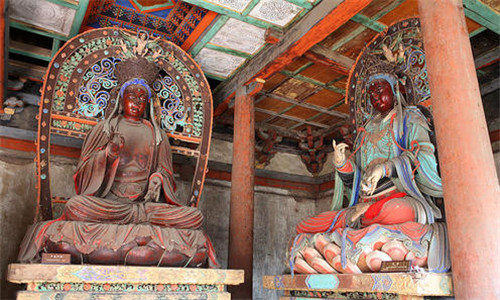
On your first day at Xi’an, you will officially begin your tour in Xi’an after your breakfast at the hotel. You will first take a 50-minute ride (40 KM) eastwards from downtown Xi’an to visit one of “the Eight Wonders of the World,” the Terra Cotta Warriors and Horses Museum. Till today, the Terra Cotta Army has impressed and amazed visitors from all over the world, including over 200 renowned world leaders and celebrities like former U.S. President Ronald Reagan and Bill Clinton, President Vladimir Putin of Russia, and the Eighth Secretary-General Ban Ki-moon of the United Nations.
According to the record by ancient Chinese historian Sima Qian, the construction of this unprecedented funerary project began soon after Emperor Qin Shi Huang ascended the throne at the age of 13 in 247BC, and lasted for nearly 40 years, involving 700,000 conscripted workers, which was about the total population of the then Xianyang city. In this site accidentally discovered by a local farmer when drilling a well for water, there are numerous life-sized terracotta figures, including over 8,000 warriors, officials, acrobats, musicians, and scholars. Incredibly, each of them is unique in terms of facial expression, hairstyle, pose, and headwear. Originally, they were not brown clay figures as they appear at present but colorful. They had black hair, pink faces, purple or red gowns, black armor, light green pants, and black shoes, yet most of their colors faded or fell off after being buried underground for over two millennia and being oxidized after the excavation. You may see the remaining colors on them if you observe attentively.
After an incredible morning, you could taste some local dishes for lunch.
For the afternoon, we will drive you back to downtown Xi’an to tour a holy Buddhist place, the Big Wild Goose Pagoda. The pagoda was built to store the Buddhist materials that ancient Chinese eminent monk, Xuanzang took from ancient India. Based on Xuanzang’s inspiring journey to India, Chinese writer Wu Cheng’en in the Ming Dynasty wrote a novel entitled Journey to the West, which was one of China’s Four Classics. The pagoda was originally built with five stories. It was later renovated to its current seven stories by the famous Buddhist teaching of “saving a life exceeds building a seven-story pagoda.”
Afterward, our guide will take you to the 600-year-old City Wall. As the best-preserved old city wall in China, the 13.7-kilometer-long City Wall was built to resist and defend against the enemy. As you walk on the wall, you will see various well-preserved ancient military facilities, such as watchtowers, moat, ramparts, gate towers, arrow towers, and turrets. On the wall, you could take a leisurely walk to feel how the past meets the present in this vibrant modern city, Xi’an.
Free time suggestion: If you want to be showered in the air of the Tang Dynasty, we recommend visiting the Great Tang All Day Mall in your free time. This theme area is a grand tribute to the great Tang dynasty culture. The lighting in this area is marvelous yet tastefully done. Touring this area at night will give you an unforgettable experience.
Or if you want to enjoy the diverse ethnic culture in Xi’an, the Muslim Quarter will be a great choice for you. In the Muslim Quarter, you could taste authentic Muslim dishes and buy hand-made souvenirs. We recommend the Pita Bread Soaked in Lamb Soup (Yang Rou Pao Mo). Along the twisted, narrow black-stone-paved street, you will see Muslim men with white hats leisurely sit and talk at the stores.
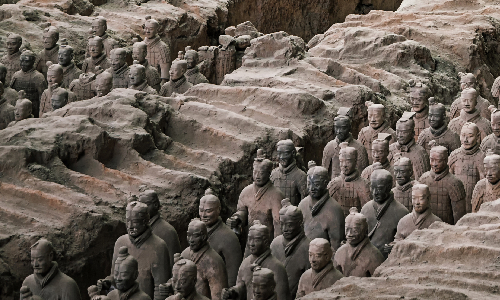

 Shanghai
Shanghai After breakfast, our guide will transfer you to Xi’an International Airport to take the estimated flight FM9202 13:00/15:05 to Shanghai. Our guide in Shanghai will wait for you at the arrival hall with your name sign. After arrival, our guide will take you to the hotel and assist you in check-in. In your free time, you may have a nice rest at the hotel or catch an early glimpse of the city by walking around.
After breakfast at the hotel, you will first visit a classical Chines garden, the Yu Garden (closed each Monday). The garden was first built by a government official Pan Yunduan in the Ming Dynasty for his parents to enjoy a tranquil and leisure retired life. Small as the garden is, it features all the architectural elements Chinese classical gardens should have, such as pavilions, rockeries, ponds, cloisters, and halls.
After sightseeing in the Yu Garden, you will visit the Shanghai Museum (closed each Monday). The exterior design of the museum symbolizes ancient Chinese philosophy of round heaven and square earth. The museum built in 1952 houses a huge number of ancient Chinese arts and is praised as “housing half of the Kingdom of China’s cultural relics.” In this museum, you could see a wide range of precious arts, including categories like bronzes, ceramics, paintings, calligraphy works, sculptures, jade artifacts, furniture, seals, ancient currency, etc.
In the afternoon after lunch, you will go to the landmark building of Shanghai, the Shanghai Tower. With a height of 546 meters, it is China’s tallest skyscraper and second in the world. The world fastest elevator will take you to the observation deck at the 118th story within 55 seconds and take you back to the first floor in 70 seconds. From the deck, you could have the city’s skyline in your eyes.
Later, you will take a walk at the world-known waterfront area, the Bund. You will have time to take pictures of the city’s dazzling buildings along the Huangpu River. Then you will visit a century-old shopping street, the Nanjing Road. In the street, you could explore both the traditional department stores and the latest international fashion stores, like the world’s biggest Apple flagship store in Asia. You will soon immerse yourself in the joy of shopping here.
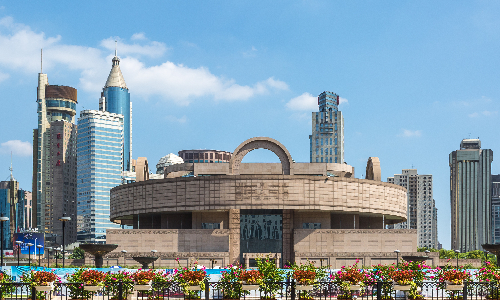

This morning after breakfast at the hotel, we will drive southwest for about one hour to Shanghai’s Venice, the Zhujiajiao Ancient Water Town, also known as “the Pearl Town”. With a history of over 1,700 years, this fan-shaped town features distinctive old wooden or stone bridges, small rivers, shady and lush willow trees, and courtyard houses, giving modern people a brand-new world of leisure, and tranquility. You will sightsee this ancient water town on a boat first, then you will have some free time to explore further by yourself.
After lunch, you will visit the Jade Buddha Temple, which was built two hundred years ago to enshrine two big jade Buddha statues that the famous monk Huigen brought from Myanmar. Both statues are decorated with precious emeralds, agates, and pearls. One statue is in a sitting position; the other is lying on the right side with the right hand holding the head and left hand placing leisurely on the left leg. If you are lucky, you may see a Buddhist conducting Chao Du, a Buddhist rite performed to release the souls of the deceased from purgatory.
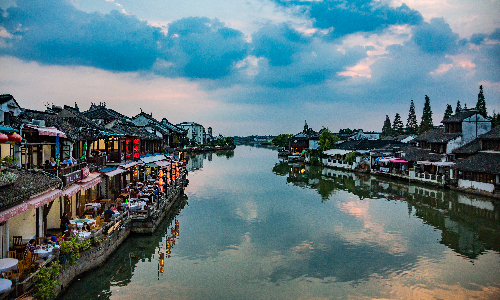

Today will be the last of your journey. Our guide will help you check out, take you to the airport according to your flight schedule, and see you off. We are looking forward to seeing you on your future tours.
Editor: Qin Zhengjin
Proofreader: Summer Hou
| City | Five Star hotel list | Four Star hotel list |
|---|---|---|
| Beijing | Sunworld Dynasty Hotel Beijing Wangfujing | Sunworld Hotel Wangfujing |
| Pingyao | Pingyao Yide Hotel | Pingyao Dejuyuan Guesthouse |
| Xi'an | Tianyu Gloria Grand Hotel Xi'an | Sunworld Dynasty Hotel |
| Shanghai | Ocean Hotel Shanghai | Courtyard by Marriott Shanghai Central |
 |
![]() About your child or infant, please contact us for a discounted price.
About your child or infant, please contact us for a discounted price.



We started with a few days in Beijing & ended in Shanghai, from where we visited the Forbidden City and Great Wall. In between we visited Terra Cotta Warriors Museum, Panda Base, Shanghai Disneyland.

We had a wonderful holiday in China which will remain long in the memory. China is a breathtakingly beautiful country full of splendid temples and palaces, mountains and rivers, peaceful rural scenes and bustling shopping streets.
 QUICK ENQUIRY
QUICK ENQUIRY